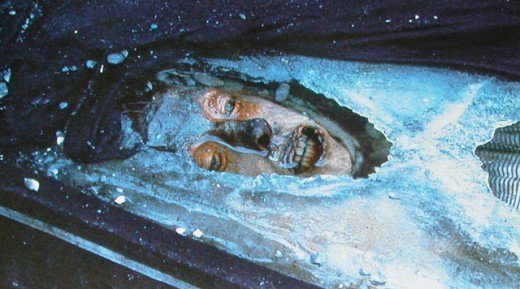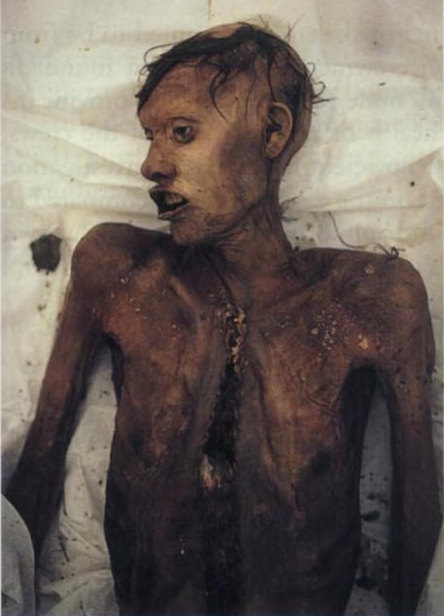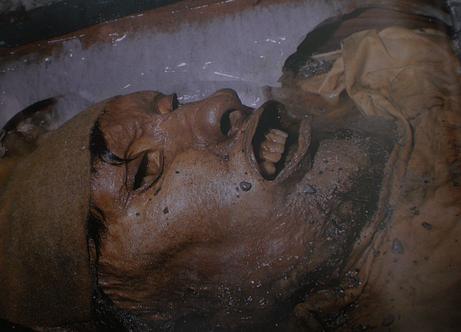#tw:human remains
Text
The Smalls Lighthouse Tragedy that changed the lives of the keepers
The original Smalls Lighthouse was built in 1775-76 and designed by a Liverpool manufacturer of musical instruments. The lighthouse stood (a replacement tower from 1861 still stands) on a small island near the tip of a remote peninsula in Pembrokeshire, Wales. In 1801, the already aging lighthouse was manned by two keepers, Thomas Griffith and Thomas Howell. The keepers were known to have difficulties with each other, frequently arguing and threatening each other with physical harm. When the two were alone at the lighthouse in 1801, Griffith suffered an accident and died weeks into his suffering. Howell did not know what to do with his partner's body. Throwing the body into the sea was out of the question, as Howell feared being suspected of murdering his partner, given the pair's famously volatile relationship. At first he kept the body in the keeper's flat. But since Griffith, like every body, went the way of all things earthly and began to decompose. Howell had to come up with something else. Now he had been a barrel maker and made a makeshift coffin out of boards and put the body in it. The rock couldn't be penetrated and there wasn't much land, so he attached it to the outside railing just outside the windows.

The first Smalls Lighthouse (1775-6) (x)
Howell now maintained the beacon himself. In the meantime, the wind and waves shattered the coffin, exposing the body so that it could be seen. As the surf rocked the remains of the coffin back and forth, the body rocked with it, and one arm seemed to wave back and forth as if to summon someone - a sight Howell saw every time. Howell remained in the solitude of the desolate island, his only company being the waving arm of his dead partner. The winds and the winter were very harsh and it was not possible to reach the lighthouse from the outside for months, but what could be seen was a kind of distress signal. Now you have to know that there were no signals for lighthouses at that time. But the ships that passed by recognised that something was wrong and tried again and again to find out what had happened, but they couldn't reach the island.

The lighthouse today (x)
When Howell was finally relieved at the lighthouse, he was close to staggering, and his friends on land did not recognise him, a man with a completely broken mind. But he had managed to keep the beacon in operation during the entire time he had been manning the lighthouse alone. That it had been an accident, by the way, was believed.
The British authorities ordered that all lighthouse teams should henceforth consist of three men and no longer two, so that one poor man would not have to suffer alone next to his dead comrade for four months. This regulation remained in force until the 1980s, when automation took over the operation of lighthouses in the United Kingdom.
#naval history#lighthouse story#a bit of a horror story#tw:human remains#early 19th century#age of sail
120 notes
·
View notes
Photo

[MYTHOLOGY MEME] 3/3 Locations - Irkalla
Ruled over by the goddess Erishkigal, Irkalla is the underworld of Mesopotamian mythology. It is a place of neither punishment nor reward, but instead a dreary land where the souls and bodies of the dead continue to exist. It is called also Arali, Kigal, Gizal, or the lower world.
#irkalla#mesopotamian mythology#mythmeme#tw:bones#tw:human remains#tw:skeletons#any other trigger warnings I should put on this for bodies?#this is a thing that circe made#i play for the dead
177 notes
·
View notes
Text
Anecdote from the crypt
You have asked me time and again if I could tell you something nice and funny about my work. Now the question is which one do you mean, because at the moment I have three jobs at the same time, although I only have one that pays me regularly. As a tour guide in a chocolate museum. Well, I have to live on something and a child and books are damn expensive.
But let's get to the anecdote I have for you, whichever way you want to look at it, take your pick.
The following order came in at the beginning of the year. Old manor house with a small family crypt in use from 1760-1840, probably four residents, and the task was to restore and document the crypt. So it sounded like a nice little job that could be done quickly. So we went there and opened the door - heart attack. So much for small and something to do. It was an Ikea, Midsommersale, rummage table feeling in there. Everything was lying criss-crossed, total chaos, broken coffins, a mixture of dirt, mummy parts and bones everywhere. So it wasn't a small order. So first we had to tidy up, put the bones in separate boxes (fruit boxes are good for this), what was still whole remained whole and was put to one side. Skulls were stored in melon boxes, and as if there were only four inhabitants, there were considerably more.
A gentleman with a very nasty trepanation, so whoever it was, I wasn't surprised because the poor man hadn't survived. The incision was three thick with overlapping incisions, and the size of a dvd, probably a medical student. A risky tumour of the thigh and a pelvis with a small child's skull in between, a trouser leg with a leg, in short, everything imaginable was there. Now, after three days, I had the task of putting the mummia, the remains of the mummies, into a box when a strange cigar-shaped ball of material, about the size of a palm, fell into my hands. I look at the thing all the time and don't know what it is, was it a package of material? a filling? whatever and while I'm thinking about it my mentor comes and says: "How long are you going to look at this penis?" Before I knew it, the good thing would have fallen out of my hand into the dirt. But I still managed to catch it. Well, what do you do with a mummified penis? first i put it aside, because i didn't want to throw it away either, after all it belonged to someone.
After a week, we were done and everything was sorted and prepared. some well-preserved coffins were back in their places and the rest had been given a large chest for storage. Only the penis had its own little box. Maybe its owner would appreciate that it was at least still there. And I now knew what it looked like if I ever came across a mummy penis.
44 notes
·
View notes
Note
Are there any other "Navy" mummies besides the Beechey Boys?
Hi,
well, there is. But be careful, big trigger warning - mummy and other human remains are mentioned here.
May I introduce John Paul Jones ? one of the fathers of the American Navy as he is also called. On the photo he is 158 years old and very well preserved for a mummy, especially the hair. And the kind of hair he had, God, it makes one jealous.
I can't think of any others, and nobody knows what Nelson looks like because nobody has looked into the coffin. Either there's a mummy in there or there's human soup. Because he was buried in a lead coffin and then in the Battle of the Nile coffin and if the lead coffin was well made then that's not very appetising in there because he can't really decompose because of the lead. But if he was lucky and the insertion did something, then he is halfway mummified, but I don't think so.
But now you've made me curious and I'd like to see if there are any others. Have a nice evening.
33 notes
·
View notes
Text
The Franklin Expedition- The Mummies
- BIG WARNING : Mummies and human remains in that post-
As mentioned here, three deaths occurred during the first hibernation on Devon Island in 1846. In the course of the first archaeological investigation, the Canadian anthropologist Owen Beattie travelled to Beechy Island in 1984 to find out more about the death circumstances of the entire crew. After long back and forth and with permission of Canadian and English side as well as the descendants he was allowed to examine then the human remains. But what went so far that he had to pack every single stone in order to be able to restore the original burial later.

(Beechy Island and the Three graves, there is fourth one from the recuse expedtion)
What he found in the summer of 1984, however, no one had justice to. The first grave he opened was that of John Torrington, his coffin was made of mahogany and covered with blue felt, on the lid was a heart made of a can, then the following inscription 01.01. 1846 John Torrington Age 20 petty officer HMS Terror

The body still looked like Dressed in a grey button up shirt, his limbs were tied with linen strips, remnants of how his body was placed in the coffin. Toes and hands were perfectly preserved. The skin had a leathery appearance but overall were completely void of decay even after 130 years in the ground. As the team continued to thaw the ice in the coffin it became apparent that Torrington's face was covered in fabric.

When this fabric was removed, the team got the most unexpected fright of their lives. John Torrington was starring back at them, literally. It would be a moment they would never forget. After they had once completely defrosted him, he was undressed and examined in detail. As it turned out, John was very ill and extremely thin at the time of his death, he weighed only about 38.5 kilograms at a height of 162.6 cm.

(John Torrington)
After the removal of bone parts, hair and material, the body was buried again. Tissue samples showed that Torrington's body had probably been stored on board the ship while his grave was being dug; significant cell autolysis had occurred in almost all areas and the cell definition was very poor. His brain had almost completely disappeared, leaving only a "yellow grainy liquid". Lungs showed scars from previous tuberculosis and signs of recent pneumonia. After the toxicological analysis showed an increased lead content in Torrington's hair and fingernails, the team concluded that Torrington had died of pneumonia. Which was probably aggravated by lead poisoning.
In 1986 the bodies of John Hartnell and William Brain were excavated. Also their bodies warned in a perfect condition and also their coffins were provided with inscriptions.
04.01.1846 John Hartnell Age: 25 able seaman HMS Erebus
03.04.1846 William Braine Age: 32 Marine HMS Erebus
Due to the fact that Hartnell died only 3 days after Torrington, the ship's doctors performed an autopsy on him in 1846, but the diagnosis at that time was only death by scurvy, but he was also diagnosed with a physical weakness and an extreme weight of about 40 kilograms, indicate tuberculosis and a final pneumonia.

(John Hartnell)
He was buried with a cap, revealing to the excavators a completely preserved black splendour of hair that had hardly been attacked by the ice. These hairs were excellent for analysis, but here, too, further tissue samples as well as fingers and toenails were taken along.


And also with it very high lead values could be determined, which indicated also here a lead poisoning. Braine's autopsy also revealed tuberculosis with final pneumonia and increased lead levels.
Beattie suggested that these men were suffering from chronic lead poisoning, which only accelerated their death by pneumonia.

(William Briane)

(A possible face reconstruction by Kristina Gehrmann)
After further investigations on bone remains he came to the conclusion that the men of the Fanklin expedition had fallen victim to lead poisoning. Keenleyside also came to this conclusion in 1996, who examined around 400 bones and could detect a very high lead content in the vertebrae. As culprits, they both kept the lead-sealed cans of canned food. But was it really like that? Recent results suggest otherwise.
#the franklin expedition#part ii the mummies#part iii will follow#sorry its a little bit long#but opinions are welcome#tw:mummy#tw:human remains
94 notes
·
View notes